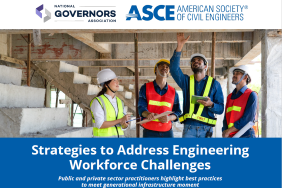This month, the American Society of Civil Engineers (ASCE) and the National Governors Association (NGA) Center for Best Practices released a policy brief identifying effective approaches for recruiting and retaining infrastructure workers. The short- and long-term strategies were collected from a group of practitioners, including America’s Governors’ offices and appointees, the federal government, infrastructure owners, operators from the public and private sectors, engineering contractors, and academics training tomorrow’s workforce.
Read the full report on ASCE’s website here: Strategies to Address Engineering Workforce Challenges
Infrastructure Law Brings Benefits and Challenges
Passage of the $1.2 trillion Infrastructure Investment and Jobs Act (IIJA) in late 2021 was a watershed moment for our nation’s infrastructure. However, with additional money from this Bipartisan Infrastructure Law, there come new challenges. Increased investment levels amid accelerating retirement trends and poor attrition rates in the infrastructure space compound existing gaps in the engineering and infrastructure workforce and threaten this generational opportunity’s overall impact.
Solving workforce challenges, the new policy brief explains, is possible using short-term recruitment and retention strategies for the engineering and infrastructure professions and long-term education and industry advancement strategies.
Short-term recruitment and retention strategies for engineering and infrastructure workers
• Identifying current workforce pain points and goals
• Evaluating compensation, flexibility, and advancement opportunities
• Incorporating caregiving needs into workplace programming and culture
• Supporting employees on the sidelines with flexible career re-entry tools
• Reducing time-to-hire and other recruitment barriers
• Reducing barriers to procurement success for small firms and disadvantaged business enterprises
• Reducing barriers to entry as the pipeline expands
• Offering place-based opportunities in communities benefiting from investment
• Building strategic partnerships with schools, skills, and community organizations
• Praising and promoting the technical achievements of infrastructure
Long-term engineering education and infrastructure industry advancement strategies
• Increasing the affordability of education
• Creating multiple entry points to the engineering and infrastructure professions
• Developing college programming for engineering student retention and support
• Encouraging high school students to enter infrastructure professions
Contributors to Infrastructure Workforce Best Practices
This report is based on insights from engineering and infrastructure leaders, and we thank them for their contributions.
- U.S. Department of Labor
- U.S. Army Corps of Engineers
- U.S. Department of Transportation
- WSP
- Government Finance Officers Association
- WSSC Water
- National Governors Association
- Office of New Jersey Governor Phil Murphy
- Office of West Virginia Governor Jim Justice
- American Society of Civil Engineers
- American Public Works Association
- American Council of Engineering Companies
- West Virginia Division of Highways
- Great Lakes Dredge and Dock Corporation
- Terracon
- KansasWorks State Board
- Washington Department of Transportation
- S&ME
- National Academies of Sciences, Engineering, and Medicine
- Lightcast
- LMS General Contractors
- Cypress Environment and Infrastructure
